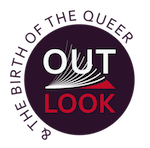In the fall 1992, a month or after we had decided to close OUT/LOOK I got on a plane and flew to New York. I was 50 years old. Several months before that my lover of three and half years had left me and I had begun smoking. I was sleeping badly and I usually woke up at 4:30 or 5 in the morning and after a cup of coffee I walked down 18th Street and along the way I climbed up a winding stairway on a rocky little hill and sat there smoking as the sun rose.
Leaving San Francisco wiped OUT/LOOK from my memory and I thought little about it over the next twenty-some years. It had been a glorious adventure but few seemed to miss it. OUT/LOOK and the Birth of the Queer is a journey back in time. Some people have spoken of the issues of OUT/LOOK as time capsules.
Memory is embedded in social and historical context. When history moves fast, it’s hard to hold on to those memories. Looking back now, it’s amazing to see the emergence of new ways of thinking about our sexual and gender identities. HIV erased some boundaries; politics followed. Queer went beyond homo and hetero. Things were getting complicated—lesbians falling in love with men; straight men going to gay bathhouses. Gender was mutable. Old distinctions had new implications: butch/femme, man/woman, homo/hetero. We lived at the intersection of many different communities, races, classes and cultures. We discovered that we occupied multiple identities and that we needed to recognize that in each other. We were living experimental lives.
Putting out every issue of OUT/LOOK was a drama—a high drama of historical meaning and complicated principle. We were making our history, unfortunately not in circumstances of our own choosing.
Live Sex Acts
One of our early ideas was repairing a long division between lesbians and gay men. A lot of lesbians were irritated by gay men’s pre-occupation with sex—especially public sex. It was after all, as Andrew Holleran noted, the age of promiscuity. And many people (not only lesbians) thought the emphasis on sex avoided more serious issues of injustice of various kinds, others thought it was embarrassing. Gay men thought that lesbians didn’t care very much about sex, but made too big a deal about feminism.
But when we started out, we discovered that both the women and men were interested in sex. Of course! Even before we published our first issue we decided we had to expose each other to our separate subcultures. The lesbians wanted to go on a field trip and see what public sex was about. In the end, only one man (myself) and one lesbian (Mimi) was willing to go on the field trip. We decided to go see the live sex act at the Campus Theater. Mimi prepared herself carefully for the big adventure. She bought a mustache, and asked the guys to help her butch up her act (she walked like a girl). She practiced talking in a deep voice. So we headed to the theater. And she bought our tickets using her deepest basso. We went down into the little amphitheater in the basement to watch the ‘live sex act.’ It was actually extremely disappointing (to me, at least). Two very cute guys grappled with one another, but I’d hardly call it sex. They had jock straps on and no discernable erections. Then one of them walked up into the bleachers and offered himself up for fondling while soliciting a little cash from us. When Mimi, I mean ‘Butch,’ made no effort to fondle the boy, he asked her to play with his butt. But she demurred and said in a high squeaky voice, “Not tonight!” That did it. He turned to me, and said, with a somewhat scolding tone, “Did she bring you or did you bring her?” After that we decided to leave. But that didn’t stop us from talking about sex in OUT/LOOK every chance we got.
We didn’t know we were living in a time of transition – when the lesbian and gay culture that had emerged after Stonewall was dying and the new queer culture was just beginning to show itself.
Photograph of Jeffrey Escoffier & Michael Sexton, NYC Pride 2017

